Summary of The Arts & Crafts Movement
The founders of the Arts & Crafts Movement were some of the first major critics of the Industrial Revolution. Disenchanted with the impersonal, mechanized direction of society in the 19th century, they sought to return to a simpler, more fulfilling way of living. The movement is admired for its use of high quality materials and for its emphasis on utility in design. The Arts & Crafts emerged in the United Kingdom around 1860, at roughly the same time as the closely related Aesthetic Movement, but the spread of the Arts & Crafts across the Atlantic to the United States in the 1890s, enabled it to last longer - at least into the 1920s. Although the movement did not adopt its common name until 1887, in these two countries the Arts & Crafts existed in many variations, and inspired similar contemporaneous groups of artists and reformers in Europe and North America, including Art Nouveau, the Wiener Werkstatte, the Prairie School, and many others. The faith in the ability of art to reshape society exerted a powerful influence on its many successor movements in all branches of the arts.
Key Ideas & Accomplishments
- The Arts & Crafts movement existed under its specific name in the United Kingdom and the United States, and these two strands are often distinguished from each other by their respective attitudes towards industrialization: in Britain, Arts & Crafts artists and designers tended to be either negative or ambivalent towards the role of the machine in the creative process, while Americans tended to embrace the machine more readily.
- The practitioners of the movement strongly believed that the connection forged between the artist and his work through handcraft was the key to producing both human fulfillment and beautiful items that would be useful on an everyday basis; as a result, Arts & Crafts artists are largely associated with the vast range of the decorative arts and architecture as opposed to the "high" arts of painting and sculpture.
- The Arts & Crafts aesthetic varied greatly depending on the media and location involved, but it was influenced most prominently by both the imagery of nature and the forms of medieval art, particularly the Gothic style, which enjoyed a revival in Europe and North America during the mid-19th century.
Overview of The Arts & Crafts Movement
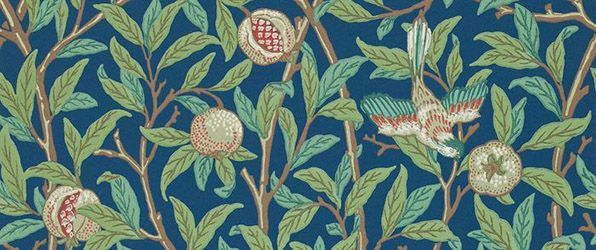
"Have nothing in your house you do not know to be useful or believe to be beautiful," William Morris said. No detail of interior design was overlooked by the pioneer of the Arts and Crafts movement.
Artworks and Artists of The Arts & Crafts Movement
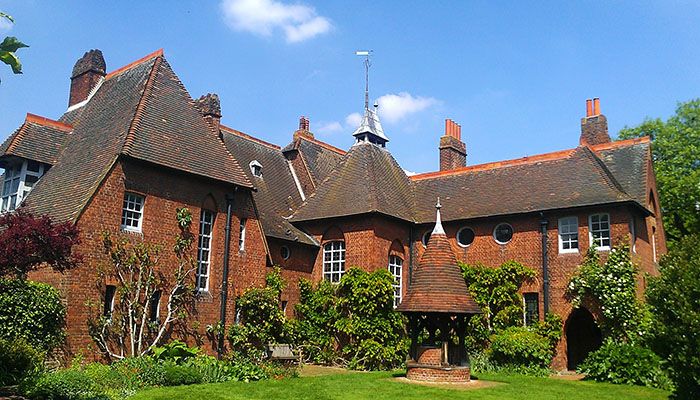
Red House
Often called the first Arts & Crafts building, Red House was appropriately the residence of William Morris and his family, built within commuting distance of central London but at the time still in the countryside. It was the first house designed by Webb as an independent architect, and the only house that Morris built for himself. Its asymmetrical, L-shaped plan, pointed arches and picturesque set of masses with steep rooflines recall the Gothic style, while its tile roof and brick construction, largely devoid of ornament speak to the simplicity that Morris preached and its function as a mere residence, though the interiors were in places richly decorated with murals by Edward Burne-Jones. The house represented a sharp contrast to suburban or country Victorian residences, most of which were elaborately and pretentiously decorated. Its location allowed Morris to remain in touch with nature, away from London's dirty, polluted core. The design, which included unusually large servants' quarters, spoke to Morris and Webb's budding Socialist inclinations towards erasing class distinctions. Unfortunately, the long hours that Morris spent commuting proved too burdensome for his productivity, and after only five years in the house he sold it and moved his family into London above the shop for his firm.
Red Brick, Wood, and Glass - Bexleyheath, London

Tulip and Rose
The Tulip and Rose curtain exemplifies the kinds of textiles and wallpaper designs produced by Morris' firm beginning in the 1860s. The dense, precisely interlocking pattern of the wool fabric, using curved and exaggerated forms of plants, flora (and sometimes fauna) became a hallmark of Morris & Company's fabric and wallpaper products in the 1870s and '80s.
Unlike Morris' earlier designs, which featured more naturalistic imagery, this textile demonstrates his move beyond emulation towards a sense of abstraction during his mature career. The flattened forms and the emphasis on line anticipate the stylization of nature later used by Art Nouveau, and calls attention to the nature of the wool's rough surface texture, thereby revealing the honesty in materials. Furthermore, the "hanging" quality of the imagery of plants and flowers speaks to the way vines cover an entire exterior wall surface - much like the curtain is supposed to cover the entire plane of a window, creating a consonance between the natural elements and man-made articles, in effect bridging or blurring the boundary between the natural world outside and the interior, even when the curtain is completely closed.
As much as the forms here look forward towards Art Nouveau, their flattened quality also looks backwards towards the forms of plants and living elements as depicted in Gothic stained-glass windows, and the curved linearity of the plants could also be said to mimic the forms of Gothic tracery. In this sense, the textile is as much revelatory of Morris' background and love of the Gothic as it is a forward-looking formal experiment.
Wool curtain, triple-cloth weave - Cooper-Hewitt Museum, New York City
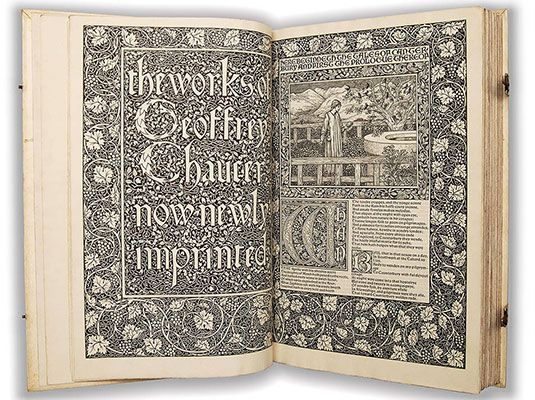
Geoffrey Chaucer's Canterbury Tales
The tomes that William Morris produced during the last six years of his life were the epitome of the luxurious pieces manufactured by his firm. They were designed as art objects to be experienced as much as books to be perused, so much so that it is difficult to read them straight through like an ordinary text. The decoration is so lavish and elaborate, overwhelming the printed text to such a degree that one is compelled to stop at every pair of pages and examine it with care before attempting to continue with the narrative (put forth in generally small type). One is immediately struck by the sheer amount of labor involved in creating the plates for printing, the typesetting, the process of making the paper and the binding, along with the cover decoration. The Chaucer, which was the jewel of Morris' volumes made at the Kelmscott Press in an edition of only 425 copies, resembles the ancient medieval colophons with painted calligraphic script and thick binding.
The binding is secured when the book is closed with latches, suggesting that the process of reading the work is akin to opening a kind of sacred tome or a treasure chest and that what is contained inside is extremely valuable. The choice of Chaucer, a medieval English author, for the text, is representative of both the connections of the Arts & Crafts with the Middle Ages and Morris' own deep appreciation of literature (he was offered the post of Poet Laureate of Britain the following year but turned it down). Ironically, despite Morris' desire that a book like this would produce joy and pleasure in an ordinary reader, it paradoxically was never accessible to any but the wealthiest of his clients, and arguably its overwrought design renders it difficult to comfortably handle or digest for simple legibility.
Engraved, woodcut prints, paper, and ink - The British Library - Boston Spa, Wetherby, West Yorkshire, UK
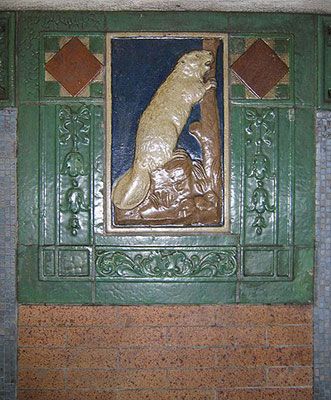
Beaver
The subway tile here represents the way mass production became a hallmark of the Arts & Crafts movement in the United States and ultimately put an end to the large-scale use of handcraft by most design firms. Grueby, founded in 1894 in Revere, Massachusetts, was known primarily for its production of art pottery vases, often using the matte cucumber green glaze that can be seen here as well. But the company was also renowned for its architectural tiles, which it instead produced in molds. In 1904 the company, which had built a name for itself by earning several gold medals at international fairs, was awarded the contract for the pictorial tile revetments in the stations of the new Interborough Rapid Transit lines of the New York Subway. This was not enough, however: Grueby's mass-production competition forced it into bankruptcy in 1909, and after a decade of instability, the company closed for good in 1920.
The tile is significant for the Arts & Crafts in many respects. The beaver, like most of the other stations' tiles produced by Grueby, recalls the naturalistic or rural imagery characteristic of the movement and provides a softer antidote to the otherwise industrial character of the stations (emphasized by the natural colors). Here, the beaver has a double meaning, as Astor Place was named for the Astor family, who had built their fortune in part through fur trapping of beavers in the Pacific Northwest; on the other hand, "Astor" itself is nearly synonymous with the Latin word for beaver, "castor." A simple frame with a geometric design and low garland relief surrounds the beaver, emphasizing the flatness of the surface.
Ceramic tile - Astor Place Subway Station, New York City
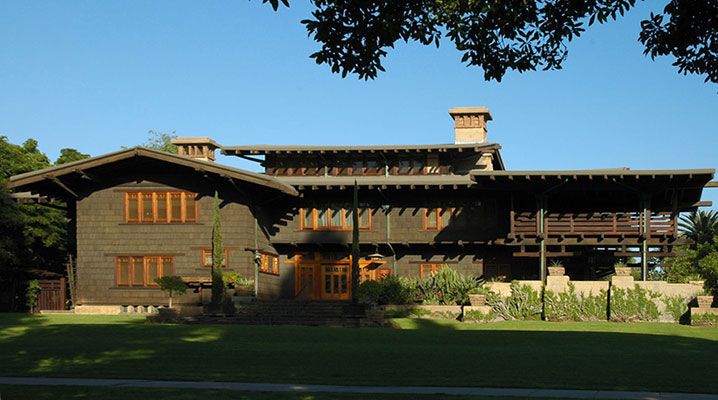
Gamble House
If the bungalow is the quintessential Arts & Crafts house, the Gamble House could be described as the perfect "overgrown" example. Designed by the architectural firm of the brothers Greene & Greene, Massachusetts transplants to southern California, for the eponymous executive of Procter & Gamble, the house demonstrates the way that the movement's notions of simplicity and homeliness were transformed into the preserves of the upper classes. It remains the best example of the Greenes' architectural work and is sometimes described as an exemplar of the Western Stick Style.
The Gamble house exhibits consonance with nature in nearly every respect. Its low, horizontal profile is exemplified by the covered second-floor porch and wraparound terrace extending from the front entrance to the back garden. The painted olive hue of the shingle siding almost seems to blend with the verdant trees and is offset by the stained wood of the frames for the doors and windows. This brown hue extends to the interior and multiplies with inlays in various surfaces, thus creating a sense of continuity between outside and inside. Such harmony is finally reinforced by the stained glass of the front door, which features imagery of a Japanese black pine, acknowledging the house's location on the Pacific Rim. The interior, meanwhile, exudes a gentle warmth and sense of informal comfort despite not being brightly lit, a quality highly desired in an Arts & Crafts residence. Finally, the Greenes designed the house with a painstaking attention to structural honesty, extending the rafters underneath the roof to the ends of the eaves and exposing the joinery on staircases, beams, and posts on the interior.
Pasadena, California
Vase
Newcomb College Pottery is emblematic of a well-known regional strain of the Arts & Crafts movement, and the most famous of those located in the American South. It also bears the distinction of being one of the few Arts & Crafts centers that was directly attached to an institution of higher education, the women's college of Tulane University. This vase, painted by Sarah ("Sadie") Irvine, the best-known of the Newcomb Pottery designers, shows the most popular theme for the vessels they produced: the "Moonlight and Magnolias" imagery of broad-canopy live oak or magnolia trees, adorned with moss drooping from their branches, silhouetted against a night sky with a full moon. The most naturalistic and least stylized of the various Newcomb Pottery designs, this imagery clearly roots the piece in the region of the lower Mississippi River valley, where magnolias are abundant, as if to advertise directly its origin.
But as much as the vase reveals about the region where it was made, it also discloses how the large artistic American Arts & Crafts enterprises created a brand for their products that simultaneously diminished the identities of their individual artists. Although Irvine was one of the most important painters of Newcomb vessels, working there from 1908 to 1929 before serving as a studio art instructor until 1952, the institution did not publicly promote her talents. And while her painted vessels are often marked and she was able to sell individual pieces, women were barred from the initial stages of the work's creation: school policy was that a "male potter would be needed to work the clay, throw the pots, fire the kiln and handle the glazing." It was Joseph Meyer's job to create the unfinished vessels and plates for the women to decorate; he in turn received the credit for Newcomb Pottery when it won awards at major international expositions.
Glazed Ceramic - The Metropolitan Museum of Art, New York
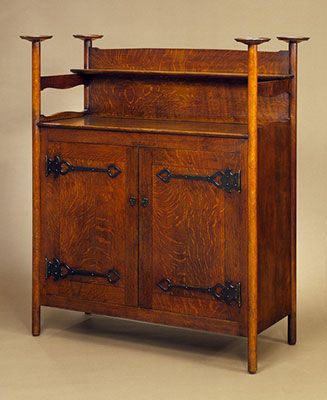
Sideboard
Voysey's sideboard illustrates well many of the tenets of Arts & Crafts furniture. The straightforward design appears so homely that one might almost mistake it for a piece of folk art. The sideboard rests on four posts that appear almost to be too thin to carry its mass; they are extremely plain, as not even the feet include fittings, and terminate in shallow circular platforms that may have been intended to hold candles, underscoring the anti-modern tenor of the environment this piece was meant to occupy. The wood, fittingly, is oak, a very common selection for Arts & Crafts furniture, which has been hewn in order to expose the grain, and stained to visually emphasize the material's texture. The organization of the sideboard's storage is honest and simplistic: a cabinet containing possibly a shelf, a counter, and a shelf above attached to the back. Virtually nothing about the piece is hidden or complicated.
The only ornament attached to the sideboard consists of the prominent dark brass hinges on the cabinet doors, which terminate in heart-shaped cutouts. They appear in some sense to be the only part of the sideboard that holds the piece together, bolstering the sense of solidity and sturdiness, while their curves provide an antidote to the otherwise severe straight lines. The hinges appear almost as if they were stolen from a Gothic cathedral door and repurposed, giving the sideboard a deceptive air that it is older than it really is and underscoring the connection with the Middle Ages, from whose aesthetics the Arts & Crafts was derived.
Oak and brass - Los Angeles County Museum of Art
Beginnings of The Arts & Crafts Movement
The Arts & Crafts movement grew out of several related strands of thought during the mid-19th century. It was first and foremost a response to social changes initiated by the Industrial Revolution, which began in Britain and whose ill effects were first evident there. Industrialization moved large numbers of working-class laborers into cities that were ill-prepared to deal with an influx of newcomers, crowding them into miserable ramshackle housing and subjecting them to dangerous, harsh jobs with long hours and low pay. Cities likewise became doused regularly with pollution from a bevy of new factories.
Critics such as the writer John Ruskin and architect Augustus Welby Northmore Pugin railed against these problems of industrialization. They contrasted its vices with the Gothic era before the Renaissance, which they viewed as an idyllic time period of piety and high moral standards as well as a healthful, green environment. For both Ruskin and Pugin, there was a strong association between the morality of a nation and the form of its architecture, and the Gothic for them symbolized the peak of human development.
The Genesis: William Morris
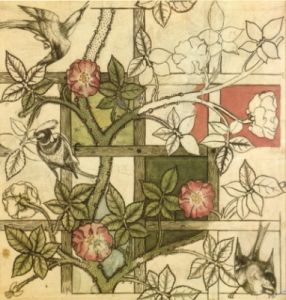
The spark for the Arts & Crafts movement was the Great Exhibition of 1851, the first world's fair, held in London. The chief criticism of the manufactured objects on display was the riot of unnecessary ornament with little concern for utility. A young and well-heeled devotee of Ruskin's commentary was William Morris, an apprentice to the Gothic-Revival architect George Edmund Street. Morris also moved in the same circles as the painter Edward Burne-Jones and the Pre-Raphaelite artists, including Dante Gabriel Rossetti, all of whom were fascinated by medieval art and nature. In 1861, Morris founded the decorative arts firm Morris, Marshall, Faulkner & Co., along with Burne-Jones, Rossetti, Philip Webb, Ford Madox Brown, Charles Faulkner, and Peter Paul Marshall, which specialized in wallpaper designs featuring natural imagery.
In 1859 Morris had commissioned Webb to design a house for his family in London, named appropriately "Red House" due to the deep color of its brick. Its steep roofs, L-shaped asymmetrical plan, and overhanging eaves recall the Gothic style, with the brick introducing a simple, pedestrian touch, which contribute to its general recognition as the first Arts & Crafts building. Residences, viewed by the Arts & Crafts practitioners as a bulwark against the harsh conditions of industrialization, a regenerative spiritual haven, and the locus of the traditional family unit, became the building type most associated with the movement (a rather interesting occurrence, as most people associate "Arts & Crafts" with hand-made objects).
Morris' firm grew throughout the 1860s and 1870s, especially as Morris garnered important interior design commissions, such as for St. James's Palace (1866) and the Green Dining Room at the South Kensington (now Victoria & Albert) Museum (1866-68). It also expanded in terms of the range of items that it manufactured, including furniture, such as the famous "Morris chair," textiles, and eventually stained glass. In 1875, Morris - whose relationship with Rossetti especially had deteriorated (in part due to Rossetti's affair with Morris' wife) - bought out his partners and reorganized the firm as Morris & Co.
Morris' firm emphasized the use of handcraft as opposed to machine production, creating works of very high quality that Morris ultimately hoped would inspire cottage industries among the working classes and bring pleasure to their labors, thus creating a kind of democratic art. Morris himself became involved in every step of production of the company's items, thus reviving the idea that the designer or artist should guide the entire creative process as opposed to the mechanical division of labor that was increasingly used in most factories. He also revived the use of organic natural dyes. The use of handcraft and natural sources, however, became extremely labor-intensive, and Morris was not entirely averse to the use of mechanical production. Nonetheless, the popularity of Morris' work in Britain, Continental Europe, and the United States grew considerably, especially after the opening of a new store at 449 Oxford Street in 1877 with trained, professional staff.
Morris, who had taught himself calligraphy in the 1860s, had always been interested in typography and manuscripts. In 1891 he established the Kelmscott Press to print editions of Geoffrey Chaucer, and Ruskin, among others, including 23 of his own works - such as the rambling utopian novel News From Nowhere - in exquisite carefully-designed tomes that rival the artistic merits of medieval manuscripts, though the Kelmscott Press folded the year after Morris' death in 1896.
The Arts & Crafts Movement: Concepts, Styles, and Trends
Societies, Communities, and Exhibitions
Morris' success and his emphasis on vernacular and rural imagery inspired many others to create collective associations where groups of artists and artisans collaborated on designs in a wide variety of media. In 1882 Arthur Heygate Mackmurdo founded The Century Guild, a group aimed at preserving handcraft and the authenticity of the artist, whose work included furniture, stained glass, metalwork, decorative painting, and architectural design. The guild gained recognition through several exhibitions throughout the 1880s before disbanding in 1892. Likewise, in 1884 Eglantyne Louisa Jebb founded the Home Arts and Industries Association, which funded schools and organized marketing opportunities for rural communities to sustain them through handcraft cottage industries; within five years it had grown to include 450 classes that employed 1,000 teachers instructing some 5,000 students.
In 1887, the Arts & Crafts Exhibition Society, which gave the movement its name, was formed in London, with Walter Crane as its first president. It held its first exhibition there in November 1888 in the New Gallery. The aims were to "[ignore] the distinction between Fine and Decorative art" and to allow the "worker to earn the title of artist." Dominated by the decorative arts, and bolstered by a strong selection of works by Morris & Co., the first two exhibitions were financial successes. Upon switching to a three-year cycle starting in 1893, the Society's exhibitions served to keep the Arts & Crafts movement in the public eye and proved to be critical successes into the new century - though by the 1920s persistent organizational problems and the organization's antipathy towards machine production ultimately doomed its original mission.
Architecture and the Diversity in Media
In part because the Arts & Crafts constituted a comprehensive philosophy of living as opposed to a distinct aesthetic style, its scope extended to virtually every aspect of the decorative arts, design, and architecture. There were very few Arts & Crafts designers, particularly among architects, whose work did not bridge several different media. Philip Webb, Charles Francis Annesley Voysey, William Lethaby, Charles Robert Ashbee, and Richard Norman Shaw exemplify this holistic trend - furthermore, it is rare to find a progressive architect in Great Britain in the latter half of the 19th century whose career was not touched by the Arts & Crafts.
In architecture the Arts & Crafts movement did not develop into one particular building style, but could be seen in a multitude of strains. The quintessentially Arts-and-Crafts building, however, might be the classic American bungalow - the stout, boxy, single-family dwelling of one or two stories with a prominent porch, distinguished by a hipped roof with wide overhanging eaves supported by thick beams. In both Britain and the United States, the simplicity, unvarnished, and rough-hewn aesthetic of the Arts & Crafts could be seen mixed in with a variety of stylistic preferences - Queen Anne, Eastlake, Tudor Revival, Stick Style, Spanish Colonial Revival, and Gothic Revival being the most prominent. In Britain, the Garden City Movement and company towns such as Port Sunlight often made use of such "hybrid" Arts & Crafts-based styles in their designs for housing.
Relationship with Art Nouveau
One style that in particular shared many theoretical and visual qualities with the Arts & Crafts was Art Nouveau, which emerged in part from the Arts & Crafts in Europe during the late 1880s. Both the Arts & Crafts and Art Nouveau placed an emphasis on nature and claimed the Gothic style as an inspiration; both spanned the complete breadth of the various branches of the arts, with an emphasis on the decorative arts and architecture and their power to physically reshape the entire human environment; and visually, both styles made use of a rural, homely aesthetic using rough-hewn stone and wood.
It is difficult to fully categorize many designers as belonging to the Arts & Crafts movement or working in the Art Nouveau style. Henry van de Velde, Charles Rennie Mackintosh, Will Bradley, and a host of other artists and architects are just a few of those artists variously described as straddling this boundary, which remains rather unclear. Many Art Nouveau artists even freely acknowledged their debt to the writings and philosophy of William Morris. Where the Arts & Crafts emphasized simplicity and saw the machine as deeply problematic, however, Art Nouveau often embraced complexity and new technology, sometimes to the point of disguising the truth of materials for visual effect. Art Nouveau also drew on a much wider stylistic base than the Arts & Crafts, finding inspiration from the Baroque, Romanesque, and the Rococo and even Islamic and East Asian sources along with the Gothic. Its very name of "New Art" spoke to the international attempts to invent a style for the 20th century instead of rejecting the conditions of modern life. As such, Art Nouveau was also less associated than the Arts & Crafts with the power to completely change attitudes and social mores, but rather was often used to embellish and enchant the viewer into a dreamy world of pleasure, sometimes tinged with exoticism.
Spread to the United States
British Arts & Crafts were known in the United States from the 1860s, and their ideas were disseminated freely through newspapers, magazines, and journals throughout the 1880s and 1890s. A key date was 1897, the year the first American Arts & Crafts Exhibition began in April in Boston's Copley Hall, featuring more than 1000 objects by 160 craftsmen, half of whom were women. Its success gave birth to the Society of Arts & Crafts at the end of June, dedicating itself to "develop and encourage higher standards in the handcrafts," with an emphasis on "the necessity of sobriety and restraint" in design, along with "due regard for the relation between the form of an object and its use." Charles Eliot Norton, professor of art history at Harvard University, served as the SAC's first president. Equally as important, that same year at Hull House in Chicago under the auspices of Jane Addams the simply-named Arts & Crafts Society was organized, as an outgrowth of the Progressive Movement, functioning as a tool for teaching new immigrants useful skills to support themselves.
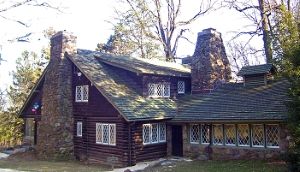
Even before then, the collectivist spirit of the Arts & Crafts had struck a vein with ambitious American reformers. In 1895, Elbert Hubbard, a bookish, loquacious former soap salesman who had visited England and drunk deeply from the ideas of William Morris, founded the reform community of craftsmen in East Aurora, New York, called Roycroft. Over the next twenty years, Hubbard's compound of metalworkers, furniture shops, leatherworkers, and (of course) printers and bookbinders would become one of the most ardent representatives of the movement in America until his death on the Lusitania in May 1915. Similar notable utopian communities centered around the Arts & Crafts sprang up in places such as Rose Valley, Pennsylvania and the Byrdcliffe Colony in Woodstock, New York. In 1907 the furniture manufacturer Gustav Stickley founded a manual-labor school for boys called Craftsman Farms in Parsippany, New Jersey, as an experimental, immersive Arts & Crafts environment, but it soon turned out to be a financial failure and Stickley ended up moving his family into the buildings instead.
Corporate Culture
Unlike their counterparts in Britain, many of the American practitioners and advocates of the Arts & Crafts Movement were motivated by a distinctly capitalist drive, viewing the simple aesthetic of the Arts & Crafts as a way to ennoble the new consumerist mass society created by industrialization of the late-19th century with a kind of moral influence that would create a sense of social harmony. Hubbard and Stickley, whose furniture designs were sold both by mail order and through his showroom in New York City, did much to promote this idea - Hubbard through his magazine The Fra and Stickley through his, titled The Craftsman, which eventually gave the Arts & Crafts the popular alternative moniker "Craftsman Style." Such publications were ostensibly founded with the intention of promoting a simple lifestyle, the honest use of materials in handcraft, and an independent spirit in design and construction for the common man, but their clear purpose was to market the products of their respective publishers. Concomitant with such attitudes, the major figures of the American Arts & Crafts Movement fully embraced the machine as an advantage for mass production and therefore fatter profits, not a hindrance to quality.
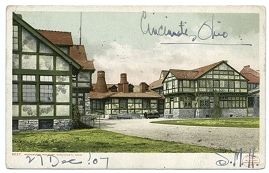
The commercialization of the Arts & Crafts in the United States might best be seen in the large corporate bodies that manufactured and marketed their crafts in mass quantities, though this aspect has not diminished their value on the collectors' market even today. Studio pottery operations such as Rookwood, Greuby Faience, Marblehead, Teco, and Overbeck are some of the best-known names in this respect, whose pieces are often known solely by their company monikers, thus diminishing - at least until recently - the identity and credit given to the designers and individual makers and decorators. Such was also initially the case at the for-profit Newcomb Pottery, part of the art school in the eponymous women's college at Tulane University in New Orleans. Other smaller pottery operations, such as Eagle in Arkansas (producers of Niloak) and Bybee in Kentucky, represent the sometimes highly regional character of Arts & Crafts design. Nonetheless, some individuals' skills with their own practices, such as the metalworker Dirk van Erp and ceramicist Ernest Batchfelder, both in California, demonstrate the diverse nature of the Arts & Crafts in the United States.
Politics
As a reactionary artistic movement that grew specifically out of social commentary and advocated reform, the Arts & Crafts Movement was destined to be tied to politics. Morris himself was the most significant Arts & Crafts figure as a staunch socialist and anti-imperialist, founding the Socialist League in 1884 and advocating worldwide workers' revolution, giving public lectures around the UK and editing the League's newspaper, the Commonweal. Morris spent more time in the 1880s as a political activist than he did as a designer, though his reputation as a poet preceded him during his lifetime, which at least in part explains why his obituaries from 1896 barely mentioned his political views. Many of Morris' fellow artists, such as William Lethaby and Walter Crane, were also prominent socialists.
While they admired and promoted Morris' desire to restore joy to both artistic and manual labor, American Arts & Crafts adherents largely ignored or rejected Morris' political views. Hubbard and Stickley, for example, made no secret of their capitalist ambitions, and marketed their work expressly to a growing middle-class audience as a complement to, not a reaction against, the economic system wrought by industrialization. Hubbard's professed praise of Morris, Ruskin, Leo Tolstoy, and others, which by the 1910s had evolved into an ardent defense of free enterprise and American ingenuity, earned him much criticism for "selling out." The Movement in the United States was also equivocal on gender issues: while it counted many women among its practitioners and advocates, including a few prominent ones such as Jane Addams and the architect Julia Morgan, few women Arts & Crafts artists received significant recognition during their lifetimes, and some were even limited to the type of labor that they were allowed to perform in the creative process. At the Newcomb Pottery in New Orleans, specifically dedicated to female artistic education, only the male potter (usually Joseph Meyer) was permitted to throw the vessels that the women students painted.
Later Developments - After The Arts & Crafts Movement
Alternative Names
Particularly in the United States, the Arts & Crafts Movement is known by several other names, the most prominent being the Craftsman Style, popularized by Gustav Stickley (and, by extension the furniture produced by his brothers' rival furniture firms), as advertised in his magazine The Craftsman, published between 1901 and 1916. "American Craftsman" is often colloquially used for bungalows and related Arts-and-Crafts-inspired houses. The term "Mission Style" or "Mission furniture" also remains frequently used, originally meant to describe a chair made by A.J. Forbes in 1894 for San Francisco's Swedenborgian Church, but popularized in 1898 by Joseph McHugh, a New York furniture manufacturer, in reference to the simple furnishings of Spanish missions in California. Often considerable overlap exists between a Spanish Colonial aesthetic and the Arts & Crafts, particularly in the American West. On the other hand, it should be noted that the colloquial use of the term "Arts & Crafts" in reference to personal hobby-centered activities and retailing bears no relationship to the formal Arts & Crafts Movement.
Decline and Dissemination
Several factors contributed to the Arts & Crafts movement's demise in the 20th century. Fundamental to its decline was the inherent problem of handcraft - which is labor-intensive - to be easily produced in great quantities and cheaply enough to reach a mass audience. Morris was never able to solve this paradox, since his goal was to create a democratic art for the masses, and as time went on, he grumbled frequently that his firm catered to wealthy clients almost exclusively. The problems were not unique to his company, as many other Arts & Crafts practitioners on both sides of the Atlantic were forced to adopt machine production, often with a decrease in quality in order to stay afloat, and several simply went out of business. Many cooperative art colonies, particularly in the USA, discovered that such a collective enterprise built on handcraft was no longer sustainable on a long-term basis. Finally, like many other movements, the Arts & Crafts fell victim to changing tastes: at the dawn of the new century, a newfound respect for a traditional Neoclassicism emerged - the Edwardian Baroque Revival in Britain and the City Beautiful Movement in the USA - both of which largely spelled the end of the Arts & Crafts Movement as a mainstream phenomenon after World War I.
Pockets of the Arts & Crafts Movement managed to survive among individuals and collective artistic enterprises well into the middle of the 20th century. The Eagle Pottery that produced Bybee potteries in the American South enjoyed their best years during the 1930s, and the Newcomb College and Teco potteries continued production into the early 1940s. The Arts & Crafts Exhibition Society still exists in modified form as the Society of Designer Craftsmen and holds periodic exhibitions. As with many movements of design and architecture - and even more so than most - the Arts & Crafts aesthetic continues to influence cheap, highly commercialized lines of products - particularly using faux and synthetic materials - frequently marketed today in department stores and by other retailers.
Legacy
The notion of craft and the visibility of the artist's hand as a central tenet of creative production, as the Arts & Crafts Movement encouraged, proved inspirational for many different artists, designers, and collective movements in Europe and North America, often at the same time as the Arts & Crafts itself flourished. In Scotland, Charles Rennie Mackintosh and the Glasgow School are sometimes grouped in with other Arts & Crafts designers. Many proponents of Art Nouveau cited William Morris as a major influence on their work, and the movement was especially admired in Austria and Germany, where design schools based in handcraft, artists' colonies like that at Darmstadt, and planned garden cities echoed the tenets of the Arts & Crafts and claimed it as their direct ancestor. Such was the case with the Bauhaus as founded by Walter Gropius in 1919, which perhaps went further and exhibited distinctly socialist tendencies that forced the school to relocate multiple times before its closure in 1933.
Useful Resources on The Arts & Crafts Movement
- The Arts & Crafts MovementOur PickBy Rosalind P. Blakesley
- The Arts & Crafts Movement (World of Art)By Elizabeth Cumming and Wendy Kaplan
- The Arts & Crafts Movement in the Pacific NorthwestOur PickBy Lawrence Kreisman and Glenn Mason
- William Morris Full-Color Patterns and Designs (Dover Pictorial Archive)By William Morris











